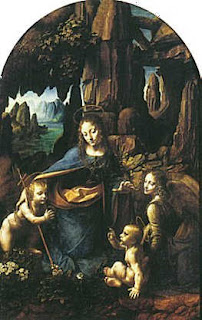The philosopher, Santayana, said that perceptions are like seeds in a plowed field or sparks in a keg of gunpowder. Images seen are not singular events but only the start of a reaction. A work of art continues to affect us long after we have stopped standing in front of it in a gallery or museum.
The technique which is used to produce that work of art and start this chain reaction is, according to Dewey, the result of the skill the artist possesses in managing the elements that constitute its form. The artist's techniques have evolved, not so much because of the limits of craftsmanship but to solve problems encountered in the experience of painting.
 | ||
| Madonna of the Rocks by Leonardo Da Vinci |
Dewey presents artists as natural-born experimenters, never satisfied with the status quo. A need to convey a deep-felt experience to the world motivates the artist in his mind. This need is never quite satiated, which leads to further experimentation in technique. The result can be almost mystical at first impression. The painter Delacroix declared, "before knowing what the picture represents, you are seized by its magical accord." The artist has touched upon something universal that connects with the viewer.
One of the principal tools that an artist can use is rhythm. Rhythm is elemental to human experience and something we all recognize instinctively. The rhythms of the seasons, the cycles of the moon, rest, and work, it is at our very core. Art can tap into this subconsciousness through its use of shape, color, and line to create its own rhythms.
 |
| The Third Class Carriage by Honore Daumier |
The role of the artist was to assist in bringing all experience into the light. Dewey states, "(i)t belongs to the very character of the creative mind to reach out and seize any material that stirs it so that the value of that material may be pressed out and become the matter of a new experience."
"Reynolds must have turned over in his grave at the unveiling of Warhol's soup cans." - Indeed. But if Dewey's right, Reynolds must've been wrong. Right? If we're "bringing all experience into the light" we can't ignore pop culture. Or soup.Or urinals? Did Dewey say anything about Duchamp's Fountain?
ReplyDeleteRight, Reynolds was too restrictive and no, no talk of the Fountain.
ReplyDeleteIt seems to me that one of the roles of an artist is to cause us to stop and look at things in a different way. The artist helps appreciate what we may take for granted, whether it’s a mountain scene, a flower or a urinal. ; )
ReplyDelete